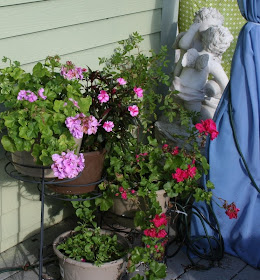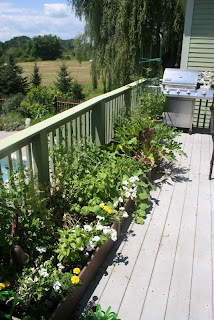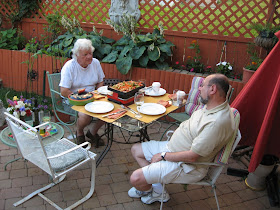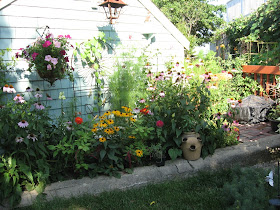When we added a few pots and raised beds last year, it was the beginning of a transformation that converted a rarely used, unattractive deck into a warm and welcoming haven that has become one of our favorite "rooms".
Prior to last year, we primarily used our deck for cooking on the barbecue grill. The color of the floor boards and style of the railings were uninspiring.
Although we had comfortable furniture, the deck was a vision in gray and tan, totally lacking in aesthetic appeal. It was not a place we enjoyed spending time. The umbrella over the table provided little relief from the broiling sun that bakes the deck for most of the day and the settee, although comfortable, wasn't at all inviting when temperature and humidity soared into the 90's. As far as we were concerned, it was wasted space.
We tried to dress it up with some potted annuals - mostly petunias and fuchsias - but we spent more time tending them than we did relaxing on the deck. I also grew the climbing rose, "New Dawn" in a pot, hoping it would grow along the rails and posts on the upper section of the deck immediately off the kitchen (the area in the above photograph).
I was hoping for the same lush growth we have on the fence behind the herb garden. That was not the best idea - it's a very thorny rose and that made it very unpleasant if you were seated next to it and it was hard to move to a more protected area for the winter.
Late last summer I transplanted it into the garden where it is much happier and this spring, I planted some hollyhocks along the rails. We have not given up on potted roses on the deck, but I am finding that miniatures make a much better option for containers and work well with the lavender we have growing there as well.
Frustrated because the rabbits and dogs had eaten most of our tomatoes the previous two summers and impressed with the success some friends of ours had growing them on their patio in large buckets, I decided to give container gardening a serious try.
We found huge, inexpensive, decorative planters on sale at K-mart and there were window boxes to match. I grabbed a couple of the long window boxes, thinking I would set them along the railing with some herbs.
Then I spotted some inexpensive kits for raised beds made from a composite material. There were only two left and since the boxes were damaged, they were heavily discounted. An idea was born and in the space of a morning, a deck garden had begun to take shape.
 |
| Two raised bed kits gave us a bed that was 4 feet wide by 12 feet long for vegetables. |
 |
| We planted sun worshipers like basil and colorful petunias in window boxes along the railing behind the table. |
 |
| Even the dogs began to spend more time on the deck, especially when the early evening shade gave a respite from the sun. |
This spring, we added both a lemon tree and a fig tree and we'll be enjoying our favorite recipes this fall as both trees are weighted down with ripening fruit.
Our first year with raised beds was successful beyond our expectations but it was also a learning experience. I learned that four foot wide raised beds might be great in the garden, but against the side of the deck, they were impossible to maintain. Reaching the plants in the back meant I had to step into them, and very quickly the dogs decided they wanted to play in them too.
The first beds we planted weren't deep enough and it was difficult to keep them from drying out. Add to that a 2 month drought and it was a daily struggle to sustain our vegetables and herbs. And they took up so much space it was difficult to arrange the furniture in a way that maximized our ability to entertain and enjoy the space.
This year we rebuilt all of the raised beds to make them narrower but deeper and easier to tend, and to make better use of the living space on the deck.
By making the raised beds only half as wide but twice as long (which required the addition of several boards from additional kits), we were able to extend them along the entire length of both the upper and lower levels of the deck, replacing the window boxes which had provided precious little actual gardening space.
We kept roughly the same amount of total planting area but with the beds and open space laid out in a more user friendly arrangement, the deck is much better suited to gardening and entertaining.
And instead of just flowers on the upper deck and vegetables in the raised beds, this year we planted a true kitchen garden that includes an eclectic mix of annuals, perennials, herbs, vegetables, and even some house plants in all of the pots and beds.
I love the fact that salad greens, vegetables, and the herbs that I cook with the most are a few steps from my cutting board.
Perhaps the most dramatic and important change we made last year was the addition of a canopy.
Near the end of the season, we found a simple to erect "pop-up" canopy that we added over the upper section to shade the table.
It took one brief thunderstorm to realize that bolting it to the deck was critical. The canopy top is held on with Velcro and when high winds or rain are expected, we simply lift the corners and undo the Velcro and let the cover sag between the struts to prevent damage from wind and a heavy collection of water.
We also found some heavily discounted cushions in an attractive blue and green print that matched the color of the house. The new cushions completely changed the color palette to one that was more to our liking.
I used 22 foot nylon window scarves that I draped loosely and secured with plastic cable ties. They are easy to install in spring and come down with a snip of the tie in fall.
Casual dining has a luxurious feel under the draped canopy and a paper and bamboo lantern fitted with an electric bulb attachment adds just enough light for dining after dark.
 |
| The area lends itself to both fancy teas with china and casual cook-outs with paper plates. |
 |
| The Meyer lemon is full of buds and small lemons. |
 |
| Squash, cucumbers, peppers, and lettuce share the space with marigolds and petunias, geraniums, and some house plants. Earlier in the season we had sugar snap peas. |
 |
| The hydrangea, Meyer lemon, and a lilac create a verdant corner. |
 |
| The wider beds have a much greater visual impact than the narrow window boxes and we were able to plant more herbs and vegetables for a true kitchen garden. |
 |
| We've added annuals to most of the large pots for extra color as well. |
 |
| These lilacs bloomed later than the shrubs in the garden and added dramatic color to the deck in June. |
 |
| Our first year with a fig tree promises to be a tasty one! |
 |
| We've added hanging pots in every nook and cranny. Here, they form a lovely backdrop for the cherub fountain. |
 |
| Early in the season we had an enthusiastic crop of sugar snap peas that climbed over and through the deck railing. |
 |
| Our Katie enjoys an afternoon nap on the settee. |







































